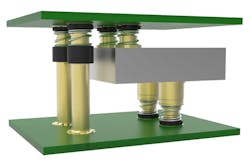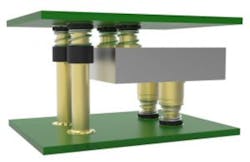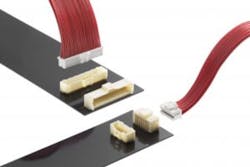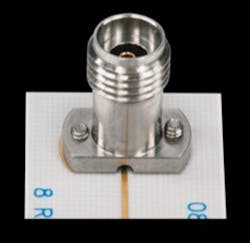January Tech Focus: Fast-connecting the masses—growing digital demands drive interconnect innovations
Digital speed requirements continue to increase exponentially,
and ever-more technology is depending on maximizing functional
circuits—with failure and latencies becoming less and less acceptable.
With standards once reserved for military and research operations,
today’s high-speed interconnect products now face the same demands
from consumer industries, data centers, and other industries.
Here’s a look at some of the latest innovations and solutions in this area.
ERFV RF coax connectors
This vendor has introduced new ERFV RF coax connectors for 5G wireless applications. Theconnectors support next-generation 5G wireless designs by implementing antenna and radio board-to-board and board-to-filter connections at a lower cost. ERFV coax connectors use a cost-efficient one-piece design and offer a high degree of customization with a range of between-board heights and connector configurations. With ERFV connectors, between-board heights can range from 5.2mm to 20mm depending on product applications such as board-to-filter or between PCBs. The connector can also be applied as a surface mount board-to-board connection or a screw-in or push-in connection into filters. In addition, ERFV coax connectors deliver proven reliability with axial misalignment tolerance of +/- 1mm, radial misalignment tolerance of +/- 0.8mm, and outstanding insertion loss and return loss over DC to 10 GHz. TE ConnectivityEthernet switch with single
An ultra-compact five-port military-grade, managed gigabit Ethernet switch with a single top-mount connector is now available from this vendor. Using a high-density D-Type 44 pin connector, the MILTECH 907 offers 5 triple speed (10/100/1000Mbps) ports to connect
Ethernet switch with single
top-mount connector
An ultra-compact five-port military-grade, managed gigabit Ethernet switch with a single top-mount connector is now available from this vendor. Using a high-density D-Type 44 pin connector, the MILTECH 907 offers 5 triple speed (10/100/1000Mbps) ports to connect networked devices on mobile military platforms. With the single top-mounted D-Type 44 pin connector and a compact size of 4.45” x 2.13” x 1.57”, the MILTECH 907 is ideal for platforms with extreme space limitations such as aerial pods, UAVs, small ground vehicles, and robotics. Advanced network features include static routing, VLANS, traffic prioritization (QoS), spanning tree, bandwidth aggregation, and security at both port and board level. With RS-232 connectors, traffic prioritization and optimization can be controlled both locally or remotely at central command centers. Designed to meet MIL-STD-461E and MIL-STD-810 810 F/GM, MIL-STD-1275/704 standards, it requires 24 VDC power and features mechanical packaging enhancements designed for airborne and ground environmental and EMI compliance. The unit has been especially hardened to improve ingress, impact, and shock/vibration protection. These devices are ideally suited for C4ISR and battlefield communications operations in harsh ground, aerial and marine environments. Techaya
Pico-Clasp wire-to-board connectors
A net set of 1.00mm pitch wire-to-board Pico-Clasp Connectors is available from this vendor. The connectors offer a variety of mating styles and orientations, plated in either tinor gold to meet flexible design specifics. The Connectors are ideal for customers in the consumer, industrial, automotive, and medical industries. The new connectors range in circuit size options, from 2 to 50, in single- and dual-row configurations. Wide header versions make them ideal for compact applications. Thick gold plating provides security that the connectors will remain reliable and intact even in harsh weather conditions. The Pico-Clasp Connectors have an easy-to-mate outer positive lock, combined with both a space-saving inner friction lock and a positive inner lock that prevents wire tangling and latch breakage. The 1.00mm pitch is one of the smallest on the market for positive lock wire-to-board crimp systems and offers a 1.0A current rating. Molex
Solderless board launch connector and test boards
Compared to current vertical mount connectors on the market, this vendor’s new TLF40-002 connector has the same footprint and mounting configuration as the currentindustry standard connectors. A simple-to-design board-level transition is all that is required to achieve performance equal to that which before could only be achieved by edge launch connectors. Instead of a 360-degree coaxial launch interface to the PCB—which requires complicated, hard to design and fabricate via structures—a simple via structure on the top layer of the board is all that is required. Transitions can be made to microstrip or grounded coplanar waveguide GCPW transmission lines. Compared to current edge launch connectors, the test boards show similar performance to edge launch connectors. The designs are simpler as well. The big advantage is in PDB fabrication, as the tolerance issues of board fabrication dealing with tolerances referenced from the edge of a board go away. Test pads can be designed into the boards for future use, and the same set of connectors can be used and re-used for measuring different boards. Signal Microwave
Sign up for our eNewsletters
Get the latest news and updates





